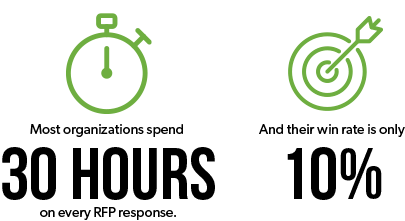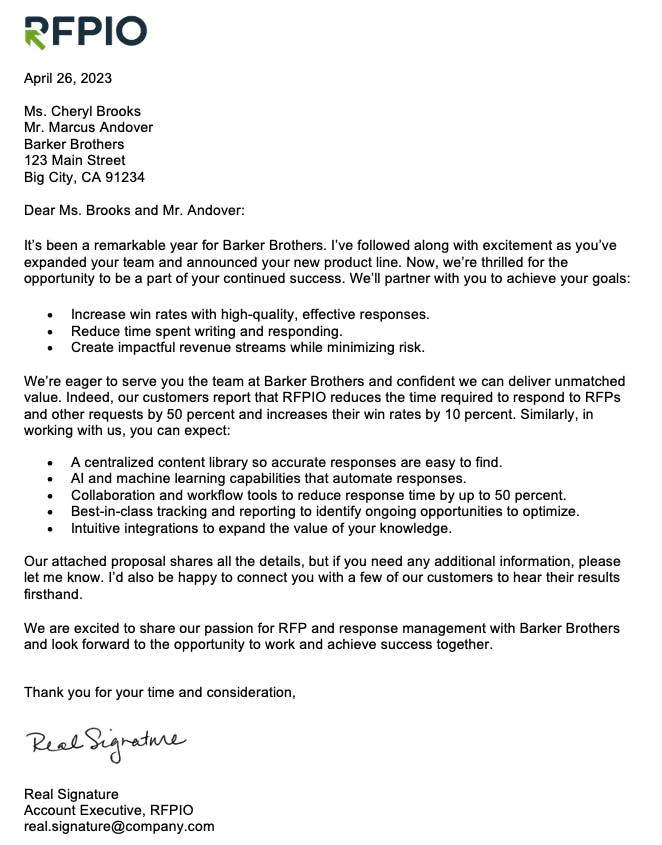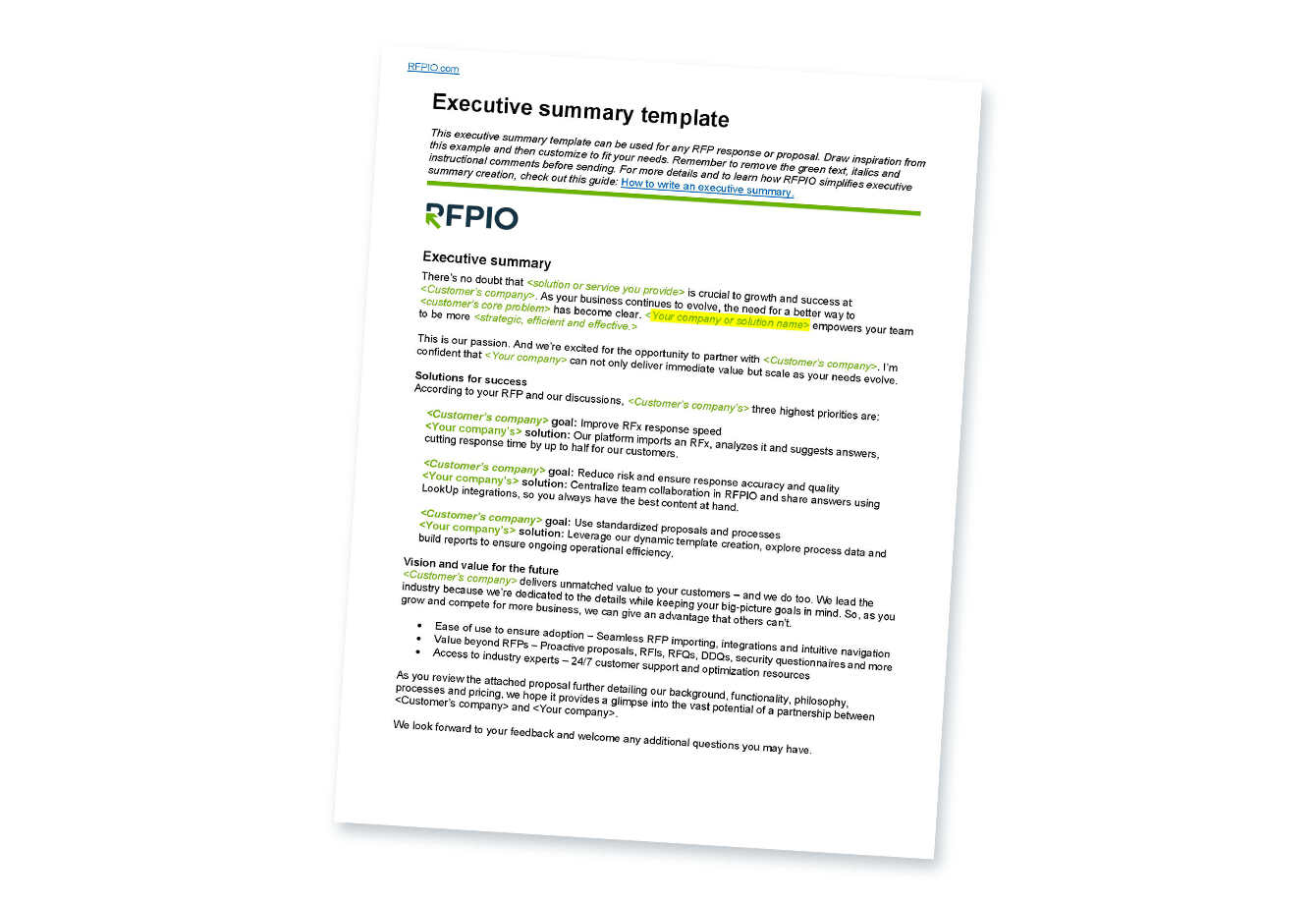Responding to requests for proposals (RFPs) can be stressful. There are so many questions to answer. For instance, what information should you include? How do you make your RFP response memorable? What are the best proposal templates to use? How do you make your business stand out from competitors that offer similar solutions? What should your proposal design look like? Where will you find the time to gather all the necessary information?
These questions are common. In this article, we’ll answer these questions as we take a deeper look at investing in an RFP strategy, improving your RFP ROI, how to find and use the best proposal templates, and more.
Investing in an RFP strategy
Naturally, everyone understands the potential value of winning an RFP. Unfortunately, far too often, businesses don’t concern themselves with the cost.
On average, most organizations spend 30 hours on every RFP response, and their win rate is only 10%. In other words, they respond to 10 RFPs, spending a total of 300 hours, before they win a single deal.

That’s a significant investment of time and money. And in some cases, it’s a gamble that doesn’t pay off.
The average cost of responding to an RFP
Let’s estimate the cost of creating an RFP response. It’s fair to assume that the RFP response work is done mostly by a proposal manager. On average, according to recent data from glassdoor.com, they average around $106,000 per year. Using that figure, we can quantify just how costly the proposal process really is.
Broken down by hour, proposal managers earn about $50.00. If they were the only proposal team members involved in the process, it would cost $1,500.00 to respond to an RFP.
However, you also must consider that many of those hours are worked by subject matter experts (SMEs) as well as executive reviewers and approvers. Typically, these experts and executives earn substantially more than proposal managers. With this in mind, it’s easy to create a picture of the true cost of creating proposals and responding to RFPs.
Additionally, when sales and marketing efforts are included to calculate the total cost, most organizations spend thousands more to win a single deal.
Mark Vignolo, Manager of Sales and Engineering at Viewpoint, faced this problem first-hand.
“Common RFPs we received had 200-300 questions, all listed in Excel. Issues really started to show up when we had to split those questions out to different people.” Mark said. “We tended to lose a lot of time just handing it off and bringing the information back.”
Fortunately, there are tried and true strategies for increasing the return on investment for responding to RFPs.
5 strategies to improve your RFP ROI
To improve RFP ROI, you must reduce proposal response time (efficiency) and increase proposal wins (effectiveness).
Here are the primary ways to accomplish those goals:
- Use proven proposal templates — RFP response templates give you a head start and a format to follow as you customize your proposal to meet your customers’ needs.
- Learn from RFP response examples — Sometimes, instructions in a template can’t paint the full picture. In that case, seeing a completed proposal example for a service similar to yours is helpful.
- Improve consistency with a response to RFP outline — An RFP outline ensures you include all the crucial elements of a proposal in the first draft. Consequently, it helps you avoid rework as the RFP deadline rapidly approaches.
- Leverage proposal management software with RFP automation — Proposal management software is transformative when it comes to speeding up your proposal process. Specifically, it centralizes your proposal content library, improves SME and executive collaboration, empowers RFP automation and streamlines workflows.
- Explore proposal tools to improve writing, design and messaging — There are a lot of great (and affordable) RFP response tools that speed your proposal timeline while improving your chances of winning the RFP.
Thanks to the knowledge and experience of our founders, internal RFP experts, customers and independent research, we put together a list of the best proposal templates, RFP response examples, proposal formats and tools you can use to simplify your RFP process.
Beyond the tools covered here, we can also learn how to create a successful RFP response process from customer stories.
The best proposal templates
The quickest way to consistently create RFP responses that work is by following a successful proposal template. Proposal templates offer a strong foundation to start from when building your proposal.
However, customization is crucial. No two RFPs are ever exactly the same, therefore, no two RFP responses should be identical. Remember, the organization you’re responding to has unique needs and challenges. Make sure you tailor your proposal messaging to best showcase how your business is the perfect fit to help them meet their goals.
Free marketing proposal template
Hubspot has dozens of free proposal templates geared toward any sort of organization. This marketing proposal template stands out as comprehensive and very well put together.
This marketing proposal template includes:
- Tips such as adding proposed team member headshots along with their titles and profiles
- A pricing calculator to help you avoid mathematical errors
- Step-by-step, fill-in-the-blank template for creating a proposal that engages your leads and demonstrates why it’s important for the client to use your company as a tool for success
- Proven, actionable messaging strategies that improve client conversion rates (and why what you’re saying is important)
5-page proposal template
This proposal template, created by consultant Jonathan Stark, is built for entrepreneurs, but it’s perfect for almost any organization. It was designed to “show you how to write proposals in a fraction of the time, increase your close rate and stop leaving money on the table.”
Jonathan Stark, the consultant who created the template, reports that he has closed “well over seven figures of business with this exact template.”
This proposal template covers:
- How to structure the proposal
- How many options to provide
- Why you should focus on benefits, not deliverables
- How to anchor your prices to the outcome, not your hours
- What pricing terms to include
- What to negotiate — and what not to negotiate!
Additional RFP response templates
These sites also offer free proposal templates:
- OpenOffice – Proposal and RFP response templates in Word and Office Suite compatible programs
- Proposable.com – Free downloadable proposal templates that are heavily designed and primarily focus on vendors who provide professional services
- Smartsheet – Offers RFP response templates in Word, Google docs and PDF
- Fedmarket – If you’re pursuing federal opportunities, this template is designed for government RFP opportunities and popular in the federal contracting world
Excellent RFP response examples
If you’ve found a proposal template you like, but still need some inspiration for filling it out, look no further. These five RFP response examples come from five different industries. However, each of them is memorable thanks to their content or their format. For inspiration, explore these proposal examples and make note of the things that you liked or didn’t like. Then, add those to your proposal template.
LCG Pence Construction education construction RFP response example
While this proposal example doesn’t include all of our recommended RFP outline sections, it stands out for its professionalism and use of visual elements. Indeed, the cover page, table of contents and cover letter provide a good introduction. And, later in the proposal, the company provides bios with photos, project plans and charts to reinforce their expertise.
5by5 website design and development proposal example
The messaging in this proposal is what stands out. Indeed, the proposal is friendly, approachable and inspiring. In addition, 5by5 does a great job of highlighting key information like their business culture, a project timeline and straightforward pricing.
JanPro Cleaning Systems proposal example
This proposal example is very easy to read and includes bullet-pointed lists, short paragraphs and company branding. In addition, the company provides its standard cleaning contract to speed the closing process if selected.
KnowInk RFP response example for polling services
This proposal is a good example of a winning bid because we know this company went to contract with the customer. Government proposals tend to be fairly dry and visually uninteresting, so KnowInk stood out by using modern graphics in their brand colors. This sample RFP is heavily redacted due to the sensitive details included, but it still offers a good example of a proposal format that wins.
Recommended RFP outline
There is no one-size-fits-all proposal outline because some industries have particular requirements. However, there are key elements almost every proposal should have.
Below is a standard proposal outline along with professional tips and ideas to keep in mind while you’re writing. To create your outline, review the RFP and jot down a few ideas for each of these sections. Then, you can quickly work from your outline to create focused messaging that resonates with your prospect.
1. RFP cover letter
First things first — introduce yourself. Your RFP cover letter offers the buyer a first impression of your company. In addition, it can be used to create or deepen your connection with the customer, reinforce your expertise and quickly highlight your key differentiators. In the cover letter section of your RFP outline, you should include space for these main components:
- Addressees
- Greeting and introduction
- Summary of RFP needs
- Your qualifications and differentiators
- Thank you and closing
Here’s a helpful example so you can see it in action.

More info: For additional advice and a step-by-step guide, read our RFP cover letter blog.
2. Executive summary
In the second part of your RFP outline, the executive summary, you must convey the benefits you deliver while you show the client that you understand their challenge or need. Remember, the person reading this page is likely very busy, needs a high-level overview and is a big influence on the final outcome. Therefore, executive summary best practices focus on high-impact, but short messaging.
Executive summary best practices
- Keep your message customer-centric
- Be brief
- Leverage your knowledge library
- Make sure it makes sense without the help of the proposal
- Follow instructions exactly
Here’s a good example of what your RFP executive summary should look like:

Ultimately, the executive summary helps the buyer decide if they’re going to continue reading, quickly skim your proposal or forget about it entirely.
More info: How to write a winning RFP executive summary—er, briefing (with template)
3. About us
The about us section — also known as the management overview — explains your story and qualifications. Brag about yourself a little. Set yourself apart from the competition by being creative about your strengths.
You aren’t small; you’re adaptive. You aren’t inexperienced; you bring a fresh new perspective. Be proud of your accomplishments. This is your time to shine, to show the client what makes you unique.
Without tooting our own horn, we think the About page on our website can give you a good idea of how to handle this section. Just like on a website, the about us section of your proposal is all about demonstrating your strengths and how those strengths will benefit the reader.
4. Answers to RFP questions
Specific customer questions and your responses are what make RFPs such a useful tool for comparing vendors. So, in this section, you’ll work to create winning RFP responses with your proposal team.
Pay attention to the content and length of your answers. While you want your answers to be thorough and customer-centric, you don’t want to make reading this section a chore. It’s always a good idea to check your proposal content library for similar questions you’ve answered in the past to save time.
5. Project schedule
Lay out the contract schedule using milestones and key dates. This will help the client visualize where they’ll be in the future.
What will their world look like? Detail when you will finish certain tracks of work and what outcomes the client can expect. Don’t get into specifics just yet—you can sort that out in the implementation plan.
6. Contract details
How will you manage the contract in terms of supervision, communication and quality assurance? What will you need from the customer to succeed? Will you conduct status meetings? How often? What sort of specific information will you report? Will the customer’s main contact transition to a customer success representative?
Use this section to reassure your customer that you have a strong process in place. Give them the outline of your plan to keep them engaged and satisfied.
7. Implementation plan
Here’s where you can sort out the details of your onboarding and roll-out plan. The work plan should tie into the overall schedule summary and will likely include some assumptions and time estimates. A matrix is a great way to display this information. Some people like to use week 0, week 1, etc. instead of specific dates. That is especially helpful if you don’t have a firm start date mandated. Just try to be as specific as possible. Other details to cover include:
- Risks or potential problems
- Location of the work or team (on-site, off-site)
- Project staffing (by name or job title)
In most cases, the project manager handles the implementation plan. Just remember to set realistic timelines and expectations that set your team up for success.
8. Price
You can’t expect to close a deal without working through the price. That’s where your proposal budget comes into play.
When creating a proposal budget, you must consider five key factors:
- Salaries
- Research and development
- Travel costs
- Operational expenses
- Profit margin
The goal is basically to show the prospect what they can expect to pay and to justify the cost.
9. References and case studies
Your potential customer wants to see proof and examples of your past successes. Generally, they are most interested in companies that had a similar need and want to read case studies. Sometimes they also want to talk to references, so having client advocates is always really helpful.
An inside look at proposal management software
Key time-saving features of RFP response software
RFP management software is designed to make the proposal process more efficient and effective. There are a number of key features that make that possible. For example, an intelligent proposal content library to store RFP responses, a customized proposal template library, collaborative workflow tools and more.
We know that, sometimes, seeing is believing. So, below we’ll explore these features and provide an inside look at how they work in Responsive.
Proposal content management
We’ve all heard that content is king. But it’s not enough to just create it; we have to be able to find it, update it and collaborate to optimize it. RFP software can help:
Your RFP system centralizes your RFP knowledge and answers, making it easy to find and update past responses. It also tracks edits, sends reminders to update responses and provides key RFP data.
Proposal template library
Store and reuse your most successful proposals so you can quickly create consistent, winning RFP responses.
Collaborate with your proposal team and SMEs
RFP response software is cloud-based. Consequently, version control becomes a thing of the past. Multiple stakeholders and SMEs can work on answers at the same time, making it easy to collaborate on proposals.
Manage the proposal process
For proposal managers, RFP software makes tracking progress easy. RFP management dashboards provide real-time updates on each task. These are visible to contributors as well so they always know what to do next.
Ultimately, the important thing is that RFP Software should streamline the RFP process — saving you time and winning more bids.
Tips and tools for proposal writing and design
In addition to RFP software, there are a lot of RFP response tools available to make your messaging more effective and your proposal process more efficient. Below you’ll find some of my favorites.
Guides to creating great content
10 simple edits that will instantly improve any piece of writing
Let’s start with some basic guidelines for writing any kind of content. Hubspot created this post to serve as a quick reference and reminder for writers. It explores how to make your content readable, relatable and engaging.
A writing GPS: The step-by-step guide to creating your next piece of content
This infographic, by the talented Ann Handley, walks through the writing process. From setting goals to reviewing, it provides guidance to ensure your final proposal achieves your goals and is error-free.
801 power words that pack a punch and convert like crazy
Sometimes, simple word substitution makes a big difference. Rather than digging through a thesaurus, start with this post from SmartBlogger about power words. It offers a list of words that are impactful and leave a lasting impression.
Proposal design tools
Just like we dress for success, we should likewise ensure our proposals are both professional and visually appealing. Including photos and infographics engages the reader and illustrates your value and data.
Free resources for photos
- Unsplash — A constantly growing collection of free photos
- PicJumbo — Another great collection of photos including a wide range of subjects
- Hubspot — Hubspot put together an exhaustive list of free stock photo sites
- Gratisography – Unique and quirky photos
- Smithsonian Open Access — 2.8 million historic, iconic public domain photos
Free resources for proposal infographics and editing
- Canva — Free resource to create proposal templates and infographics
- Venngage — Source for easy-to-create infographics
- Piktochart — Create attractive charts to illustrate powerful data
RFP response best practices from experts
Of course, all of the above proposal templates, tools and RFP response format examples won’t do any good if you don’t know how to use them to create compelling content that helps you win new deals.
That’s why we’ve compiled advice from sales and marketing experts to help you develop proposals that win.
Be thorough, but simple
“Companies spend a substantial amount of time and energy creating an RFP that will level the playing field for their potential vendors and garner the exact information they need to reach a decision. Give them what they ask for. When we prepared our RFP responses, we were thorough, but simple. We made our pitch early and often, providing only the necessary details to illustrate why our company could add more value than our competitors. Including information outside of the set guidelines may cause your proposal to be bypassed.”
— Tom Gimbel, CEO, LaSalle Network
Address the challenges your prospect wants to overcome
“Instead of focusing on what you have to offer your prospect, your proposals should focus on the key problems your prospect wants to solve. In particular, the beginning portions of your proposals should address the challenges your prospect wants to overcome. This will effectively turn your proposals into working documents that outline specific client objectives—a powerful tool.”
— Marc Wayshak, founder of Sales Strategy Academy and best-selling author of Game Plan Selling
Don’t confuse your reader
“Acronyms, technical slang and other jargon will turn your reader off faster than a sleazy pitch. Don’t confuse your reader by trying to sound smart, that’s bad for sales and bad for you.”
How to use your new RFP response toolkit
Feeling overwhelmed? Don’t worry. We covered a lot — from RFP response templates to proposal format advice, expert tips and more. But putting it all together is easier than you might think.
- First, select the RFP response template that works best for your situation
- Then, use the formatting advice to customize the content in the most effective way possible
- Next, evaluate which tools and technology will best support your RFP response process
- Finally, look over the expert tips and advice to ensure your proposal content is compelling, and persuasive and positions your organization to win
Not too bad, right? Now, you have all the tools and resources to efficiently and effectively respond to your next RFP.
